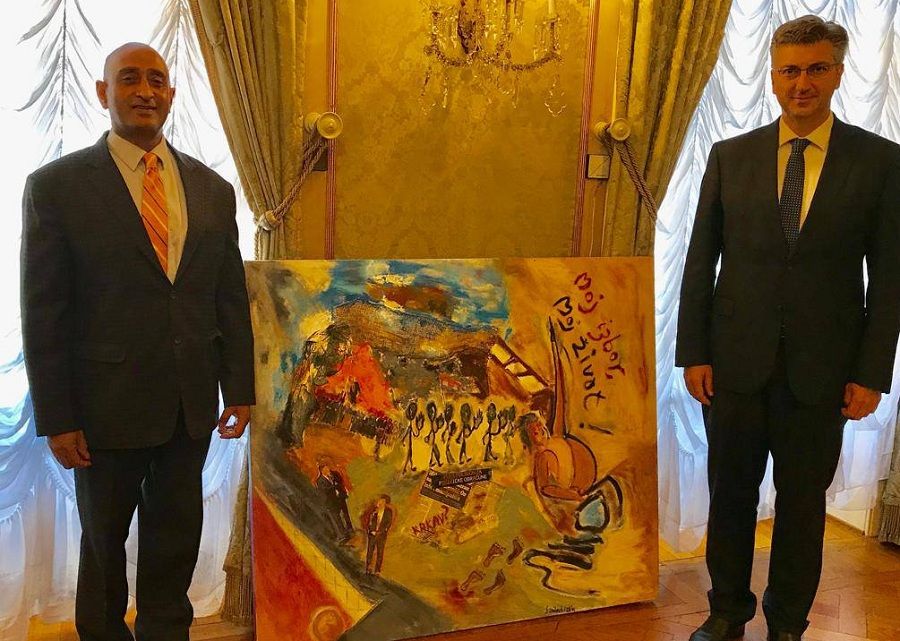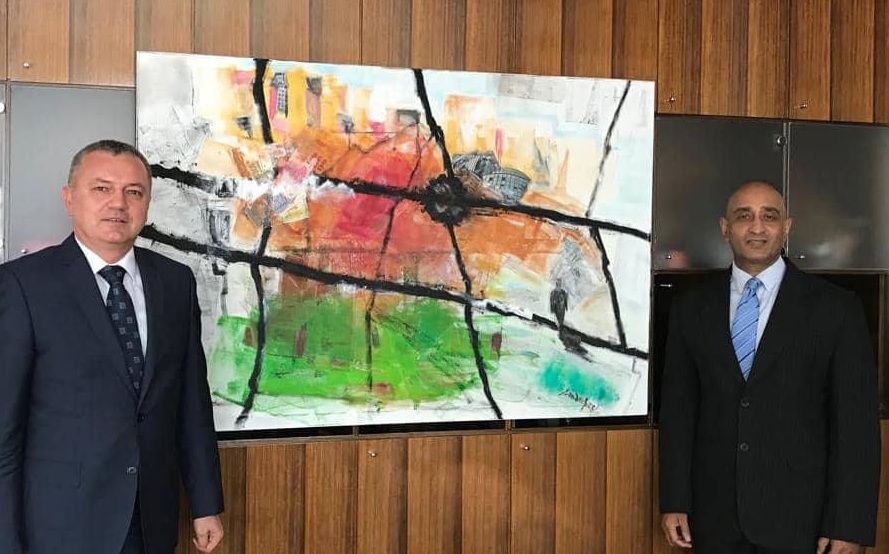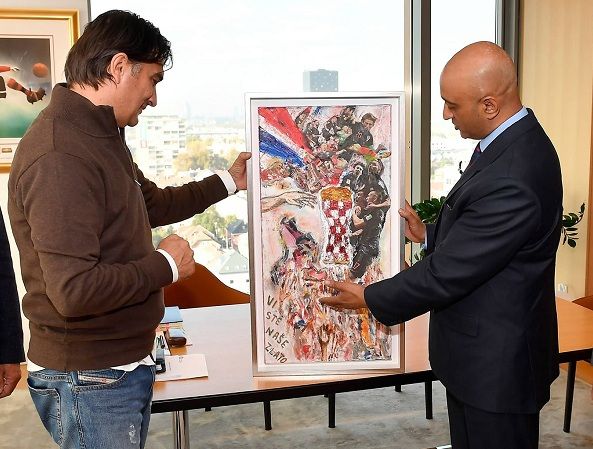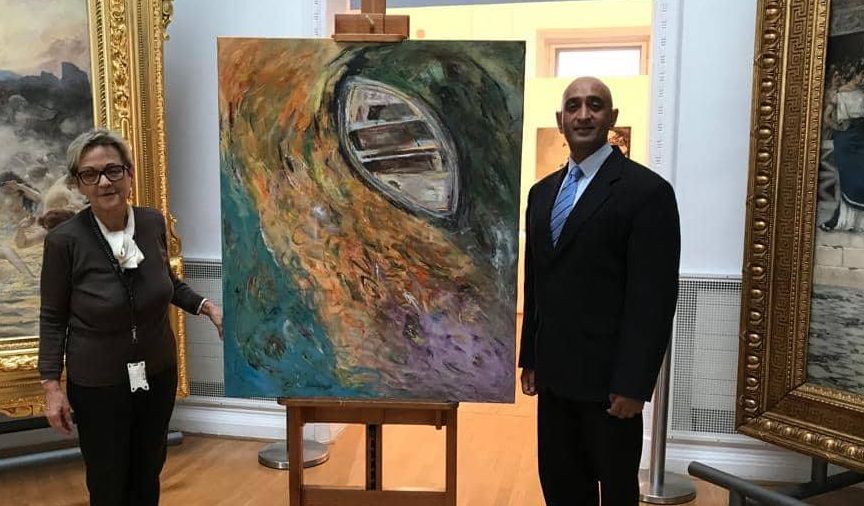Historical Frescos Found in the Cabinet Meeting Room at Banski Dvori
The palace has changed a series of owners. The first one was Ban Petar Zrinski. Then, after the collapse of his famous conspiracy, it was sold to Baron Čikulini, and in the middle of the 17th century, it was bought by Ivan Drašković Trakošćanski. After that, it was taken over by the Sermage family, and after the marriage of the daughter of Petar Troil Sermage the palace at St. Mark’s Square was taken over by Baron Ivan Emilijan Kulmer. He was the last private owner before the Banski Dvori palace became a place where main political decisions are made. Today it is the headquarters of the Croatian government, reports Večernji List on April 2, 2019.
Ivan Kulmer is most likely the one who should be credited for the artwork that had been hidden for decades under the red-gold wallpaper of the Ban Jelačić Room, where the Croatian government usually meets. It was discovered last summer when the restoration of the room began. Workers have found valuable frescos after they removed the wallpaper, and the restorers have since discovered unknown details.
The analysis determined that the artwork dates back to the late 18th or early 19th century when Kulmer was the owner of the building. They discovered that the frescoes were made with the secco technique, but the author is still unknown. At least for now, says the government, adding that it is “a Central European painter".
After the completion of all the works, Culture Minister Nina Obuljen Koržinek will sit in front of the frescos, as per usually seating chart. The murals will no longer be covered, Prime Minister Andrej Plenković announced. The government had to hire experts who are now working on their renovation.
“Damage has been noticed, such as surfaces damaged when the channels for electrical installations were put it. In some places, the painted and plastered layers of the walls were missing,” says the government. Before the works began, restorers had to create a fresco study with analysis and comparative examples to reconstruct the missing parts. Laboratory tests have been carried out, while the entire hall has also been documented with photographs and 3D laser scanning.
Currently, the experts are painting the missing parts of the composition. The frescoes are located on the northern wall and a part of the eastern wall of the room. They show a land landscape with trees, and there is the sea coast in the distance, with towns and building further away.
Translated from Večernji List (reported by Petra Balija).
More art news can be found in the Lifestyle section.
Venice Biennale "Pergola Cloud" Coming to Zagreb City Museum
A combination of architecture, art, robotics and computer programming. That was the installation which until November last year was part of the Croatian pavilion at the 16th Venice Biennale. And now, for the first time in Croatia, it will be presented as part of the 3rd Festival of Light, reports Večernji List on March 17, 2019.
It will be located at the atrium of the Zagreb City Museum. The new installation will be developed by Dean Skira, one of the most prominent Croatian light designers, along with the designers of the original "Pergola Cloud", architects Bruno Juričić and Alisa Andrašek. He will illuminate this piece of art and do the same with the surrounding part of the museum.
This is just one of the twenty locations directly below and on the Upper Town, the historic part of Zagreb, making it an ideal environment for this event. “Pergola Cloud” is a joint collaboration between the Zagreb City Tourist Board and the Ministry of Culture.
Our project focuses on the experience of being under a pergola that allows playing with the environment, mobilising environmental, natural elements, and opening up space for the poetry of living. Pergola is saturated with innovative, computer-generated modules and resembles a three-dimensional lace, said Juričić.
Together with the Ministry of Culture and the City of Zagreb, the Zagreb City Tourist Board is working with many cultural institutions and public and city services to attract more visitors to the festival, which will this year run from 20 to 24 March. The City of Zagreb, HEP, the State Hydrometeorological Service, Croatian Forests, Zrinjevac, ZET, the Faculty of Law of the University of Zagreb, the August Cesarec Centre for Culture and Film, the Klovićevi Dvori Gallery and the Croatian History Institute also help realise the project.
The Archdiocese of Zagreb has allowed the St. Catherine church to be illuminated. The stained glass windows which are usually inside the church will be projected on its front, explained the director of the Zagreb Tourist Board Martina Bienenfeld, adding that they have the great support of the inhabitants of the Upper Town, who contribute with their patience to the successful realisation of the project.
Translated from Večernji List.
More Zagreb news can be found in the dedicated section.
Renaissance Masterpiece to Be Exhibited in Zagreb for Next 8 Years
For the next eight years, Zagreb and its Museum of Arts and Crafts (MUO) will be a unique destination for international art lovers. The MUO has become the temporary home of a Renaissance masterpiece made by great Croatian-Venetian painter Andrija Medulić Schiavone, "King Saul being greeted in triumph after David's defeat of Goliath”, reports Večernji List on February 17, 2019.
It is an oil on wood painting made in Venice in 1540 which has never been publicly presented. Even the Medulić's 1980 monograph says that the work had been seen only in photographs. The dimensions of the painting are 92.5 x 109.8 centimetres.
During its rich history, the painting has changed many owners, from the London antique dealer Martino Colnaghi, through Prince Paul of Karađorđević in the 20th century, who sold it in 1969 together with the furniture of his villa, to a private collector in Italy, from where it appeared after 50 years at Christie's in London.
This is when Andrija Kojaković, the Dubrovnik-born entrepreneur, ambassador and collector, bought the painting. After being hidden for centuries, he decided to lend it to the MUO so that art lovers would have an opportunity to enjoy the work of the great Croatian painter. “Others who have such artworks should give them to the museums too and present them to the general public because enjoying something alone is a bit selfish,” said Kojaković at the MUO where he was joined by art historian Flora Turner-Vučetić and MUO director Miroslav Gašparović.
“I never wanted to compete at an auction when a Croatian institution or museum would be involved because I thought it was not fair. If more similar paintings appear in the future, I will certainly continue with my efforts,” said Kojaković, adding that he was just a person who enjoys things connected with Dubrovnik; he also owns a collection of old Dubrovnik money. He is also interested in paintings by British artists who painted Dubrovnik and old maps depicting the Dubrovnik Republic. “While I worked as an ambassador, I had to prove that Prevlaka is part of Croatia, and on all the old maps that is shown very clearly. That is why they are so interesting to me,” Kojaković said.
The temporary donation is a great honour for the MUO since this painting is one of just 20 confirmed works by Andrija Medulić, two of which are already located in Zagreb. “This is really an act of charity, which is not common in our society, and therefore this sends a message of how we should all do good for the community," Gašparović pointed out.
The city authorities also thanked Kojaković. “With this generous act, the MUO permanent exhibition will be considerably enriched during the next eight years, and this will certainly help this museum to remain one of the most visited museums in Croatia,” said Jelena Pavičić Vukičević, the representative of the Zagreb Mayor.
Translated from Večernji List (reported by Jelena Ružić).
More Zagreb news can be found in the dedicated section.
Italian Cinematographer Vittorio Storaro to Visit Zagreb
ZAGREB, February 4, 2019 - A famous Italian cinematographer Vittorio Storaro, an Oscar award winner who has worked with distinguished film directors including Bernardo Bertolucci, Francis Ford Coppola, Warren Beatty, Woody Allen and Dario Argento will be visiting Zagreb on Tuesday and Wednesday, the Academy of Dramatic Art (ADU) said on Monday.
Storaro will hold a masterclass lecture on Wednesday at the F22 ADU hall for students, professors and interested public.
On Tuesday he will make an introductory speech in the Europa cinema as part of a cinema lecture programme dedicated to film classics ahead of a screening of the 1970 film, The Conformist.
Storaro's visit to Zagreb is being organised by the Italian Cultural Institute in cooperation with the Academy of Dramatic Art and Europa Cinema.
Vittorio Storaro was born in Rome in 1940 and was actively involved in photography from an early age. In 1956 he enrolled in the Experimental Film Centre as the youngest student in his generation.
This cinematographer has won several awards. He is a three-times Oscar winner - Apocalypse Now (1980), Reds (1981) and The Last Emperor (1988).
More news on the film and arts in Croatia in general can be found in the Lifestyle section.
Monument to the Homeland to Cost More Than Expected
The bids sent to the public tender were opened in early November. That is, the only bid which has been received. Tigra and Vodotehnika companies were the only ones to apply to perform the construction works on the Monument to the Homeland, which is supposed to be located between the City Hall and the Vatroslav Lisinski Concert Hall. But they said they could do the job for 27.4 million kuna (excluding VAT), or almost six million kuna more than what the City of Zagreb initially estimated the project would cost. This prompted the city authorities to analyse the estimated cost of 21.5 million kuna (excluding VAT) for months. And finally, they have made a decision ؘ– the tender will be cancelled, and a new one announced, reports Večernji List on January 14, 2019.
This will happen, according to Dinko Bilić, the head of the City Construction Office, in early February, while the current tender, announced in August 2018, will be annulled, based on the findings and analysis of the costs by an authorised expert witness. Asked when the construction will start on the monument that should be completed by the spring of 2020 at the latest, he did not provide an answer.
Still, the monument’s author, architect Nenad Fabijanić, says that the annulment of the tender should not affect the previously planned deadlines. “The problem appeared because the cost of the works was determined two years ago, based on the main project plans, when the cost of materials and workforce in the construction sector was lower," Fabijanić says. Now the price should be corrected upwards. “If the works begin in the spring, everything would be done by late autumn. Each segment of the monument demands time, and the works should not be rushed,” adds Fabijanić.
The high price of the monument, which was particularly criticised by the opposition at the City Assembly, was explained by Mayor Milan Bandić by the complexity of the project. The oversized glass bricks will be specially produced in a Czech master workshop, following the designs of sculptor Jeronim Tišljar. The second part of the monument, a three-metre stone monolith where foreign delegations will lay wreaths, will be made from a unique Croatian stone called Adriatic Green. The third element, a 30-metre portal, will be made of particular fibre-reinforced polymer, which is resistant to most acids and corrosion, so the maintenance costs should be lower.
The new Monument to the Homeland is supposed to take over the commemorative duties from the current Altar of the Homeland at Medvedgrad, while the portal will be, according to Fabijanić, a new city gate connecting the Trnje district with the old city centre in the Lower Town. The greenery will frame the whole composition and eliminate the street noise.
More news about Zagreb can be found in our special section.
Translated from Večernji List (reported by Petra Balija).
Emigrating Artist Creates Farewell Performance
He was pulling a Mercedes on the main square of Osijek, where Ante Starčević's statue is located. He stopped at the monument, turned to him and, since he did not receive an answer, pulled Mercedes to the other side of the square. That was a farewell performance, title “My dad is the best in the world”, by multimedia artist Siniša Labrović recently in the center of Osijek, reports Večernji List on November 23, 2018.
“I asked him why he is alone and where are his children, do they call him from Dublin and Munich, do they send money, why he is silent, I asked him whether he felt shameful or guilty. I know he was against monuments and public honors. I asked him what I should tell his children if I met them around the world. ‘The Father of the Nation’ remained silent, stiff, alone and important. The performance did not look at the real character and work of Ante Starčević, who deserves respect, but at his monument in a society which he would consider a betrayal of ideals for which he once fought,” explained Labrović.
Labrović recently left Croatia and moved to Berlin, like so many other Croatians, young and old. The reasons are private and professional. “As a professor of Croatian language, I have not been able to get a permanent job in a school for ten years, after I was told by the Church that I would never get a job since in 2000 I restored a damaged monument to the partisans in Sinj. Also, earlier this year, I received an offer from the Museum of Modern Art in Zagreb, which is officially our main contemporary art institution, that I could create a performance for 500 kuna gross, both the fee and the production costs. Also, the few institutions that remained ‘normal’ are slowly being occupied by clerofascists. So we finally had to hear the message they have been whispering to us all the time – go to hell,” he explained
He moved to Berlin only recently, so he still does not know how the German culture will react to his performances. For now, he says, he is “a foreign worker in Croatia which is a thousand-year-old European country.” In November, he took part in two exhibitions in Rijeka, and he has several other projects planned.
Asked if he would be more appreciated in the homeland now that he is living abroad, he said he was not sure. “My plans are vast, but the future is opaque, so we will see. As for the appreciation in the homeland, it is likely that nothing will change.” He does expect that he will live better in Germany, given that many people are moving there and few are returning. “What the statistics mean for me, I will find out. Maybe I will be an exception,” he added.
Siniša Labrović was in the focus of the media this May when he started collecting signatures for a referendum that would ban the persecution of pedophile priests. Of course, it was just another of his performances, but surprisingly there were people who thought he was serious and who even signed the petition, claiming that priests should never be prosecuted, even if they are pedophiles.
For more on art in Croatia, click here.
Police Exhibits Forged Artworks in Osijek
In the building of the Croatian National Theatre in Osijek, the Police Museum and the Police Administration of Osijek-Baranja County have organised an exhibition of forged artworks found by the police during their investigations. This truly unique exhibition is titled “The Beauty of False Glitter”, reports Lokalni.hr on November 21, 2018.
Forged artworks are certainly some of the most interesting exhibits in the permanent collection of the Police Museum. The collection consists of about seventy forgeries, mostly paintings (oil on canvas), as well as several sculptures.
The majority of forgeries are attempts to recreate works by Croatian painters such as Edo Murtić, Zlatko Prica, Ljubo Ivančić, Mersad Berber, Dimitrije Popović, Đuro Pulitika, Vasko Lipovac, Miljenko Stančić, Vladimir Kirin, Oscar Herman, Boris Bućan, Ivan Rabuzin, Ivan Generalić, Ferdo Kovačević, Dragica Cvek Jordan, Slava Raškaj, as well as the sculptures of Dušan Đamonja and Vojin Bakić.
Among foreign authors “represented” at the exhibition, forged artwork by Salvador Dali and Renoir are the most prominent.
By presenting this exhibition, the police want to warn citizens about the unscrupulousness of players who operate on the black market, who are willing to do everything in order to make a profit, including deceiving uninformed buyers.
The opening of the exhibition was attended by Osijek Mayor Ivan Vrkić, who thanked the police for bringing the exhibition to Osijek and for raising awareness among citizens about the need to be very careful if and when they decide to buy expensive artwork.
The exhibition will be open until November 30. All those interested to see it can come to the Croatian National Theatre building in Osijek daily from noon to 8 pm. The entry to the exhibition is free.
Similar exhibitions have already been presented in several Croatian towns and have proven to be a success with the general public.
For more on the Croatian police, click here.
Indian Ambassador Paints Croatian Political Portraits, Paintings on Major Events
Ambassador of India in Croatia Sandeep Kumar has posted on his official embassy Facebook page his farewell gifts given to Croatian officials, reports Index.hr on November 1, 2018.
“The ambassador has presented the paintings that he himself painted, which show different topics such as parliamentary elections in Croatia, the crisis in Agrokor, the cathedral in Zagreb, the successful performance of Croatia at the recent football World Cup, paintings of Croatian landmarks, and a portrait of Croatian President Kolinda Grabar-Kitarović," announced the embassy on Facebook.
As could be expected, the portrait of the Croatian president was given to here. To be honest, if we did not know who his inspiration was, we would hardly be able to guess that it was Kolinda Grabar-Kitarović.
Prime Minister Andrej Plenković received a painting about the election in Croatia. Unlike president’s painting, this is much more realistic, since it shows how elections are done in Croatia – chaotically.

The ambassador gave the painting about the “Agrokor Crisis" to Minister of Economy, Darko Horvat, who entered the government precisely because of the crisis since his predecessor had to resign after her involvement in the events surrounding the affair was discovered.

Zagreb Mayor Milan Bandić received a painting of the Zagreb cathedral, while Zlatko Dalić, the manager of Croatia’s national football team, appropriately received a painting showing the successful performance of the Croatian national football team at the recent World Cup in Russia.

The Modern Gallery in Zagreb will have in its collection Kumar's painting of a boat called “Azure Adriatic".

The ambassador is now leaving Croatia, so he will presumably focus his artistic talents on politicians and events in some other country.
If you are interested to read more about Croatia and India, click here.
Naive Art Bringing Tourists to Podravina
The Croatian naive art movement is based in the Podravina region.
First Foreign Movie to be Filmed in Croatia Using New Incentives
ZAGREB, September 24, 2018 - The Master Butcher's Singing Club, a movie to be filmed at several locations in Croatia over a period of three months, is the first foreign production using incentives for filming in areas of special state concern.


